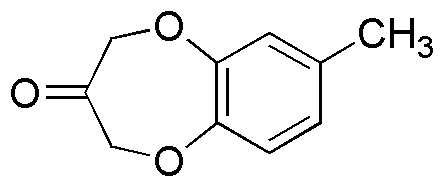7-Methyl-2H-1,5-benzodioxepin-3(4H)-one is widely utilized in research focused on:
- Pharmaceutical Development: This compound serves as a key intermediate in the synthesis of various pharmaceutical agents, particularly in the development of drugs targeting neurological disorders.
- Organic Synthesis: It is employed in organic chemistry as a building block for creating complex molecules, facilitating the design of new compounds with potential therapeutic effects.
- Material Science: The compound is used in the formulation of specialty polymers and coatings, enhancing properties such as durability and resistance to environmental factors.
- Analytical Chemistry: It acts as a standard reference material in chromatography, aiding researchers in the accurate identification and quantification of similar compounds in complex mixtures.
- Biological Research: The compound is studied for its potential bioactive properties, contributing to the understanding of its effects on cellular processes and its potential as a lead compound in drug discovery.
Informations générales
Propriétés
Sécurité et réglementation
Applications
7-Methyl-2H-1,5-benzodioxepin-3(4H)-one is widely utilized in research focused on:
- Pharmaceutical Development: This compound serves as a key intermediate in the synthesis of various pharmaceutical agents, particularly in the development of drugs targeting neurological disorders.
- Organic Synthesis: It is employed in organic chemistry as a building block for creating complex molecules, facilitating the design of new compounds with potential therapeutic effects.
- Material Science: The compound is used in the formulation of specialty polymers and coatings, enhancing properties such as durability and resistance to environmental factors.
- Analytical Chemistry: It acts as a standard reference material in chromatography, aiding researchers in the accurate identification and quantification of similar compounds in complex mixtures.
- Biological Research: The compound is studied for its potential bioactive properties, contributing to the understanding of its effects on cellular processes and its potential as a lead compound in drug discovery.
Documents
Fiches de données de sécurité (FDS)
La FDS fournit des informations de sécurité complètes sur la manipulation, le stockage et l’élimination du produit.
Spécifications du produit (PS)
Le PS fournit une description complète des propriétés du produit, notamment sa composition chimique, son état physique, sa pureté et les exigences de stockage. Il détaille également les plages de qualité acceptables et les applications prévues du produit.
Certificats d'analyse (COA)
Recherchez des certificats d'analyse (COA) en saisissant le numéro de lot du produit. Les numéros de lot et de lot se trouvent sur l'étiquette d'un produit, après les mots « Lot » ou « Lot de fabrication ».
Numéro de catalogue
Numéro de lot/série
Certificats d'origine (COO)
Ce certificat d'exploitation confirme le pays dans lequel le produit a été fabriqué, et détaille également les matériaux et composants utilisés et s'il est issu de sources naturelles, synthétiques ou autres sources spécifiques. Ce certificat peut être requis pour les douanes, le commerce et la conformité réglementaire.
Numéro de catalogue
Numéro de lot/série
Fiches de données de sécurité (FDS)
La FDS fournit des informations de sécurité complètes sur la manipulation, le stockage et l’élimination du produit.
DownloadSpécifications du produit (PS)
Le PS fournit une description complète des propriétés du produit, notamment sa composition chimique, son état physique, sa pureté et les exigences de stockage. Il détaille également les plages de qualité acceptables et les applications prévues du produit.
DownloadCertificats d'analyse (COA)
Recherchez des certificats d'analyse (COA) en saisissant le numéro de lot du produit. Les numéros de lot et de lot se trouvent sur l'étiquette d'un produit, après les mots « Lot » ou « Lot de fabrication ».
Numéro de catalogue
Numéro de lot/série
Certificats d'origine (COO)
Ce certificat d'exploitation confirme le pays dans lequel le produit a été fabriqué, et détaille également les matériaux et composants utilisés et s'il est issu de sources naturelles, synthétiques ou autres sources spécifiques. Ce certificat peut être requis pour les douanes, le commerce et la conformité réglementaire.

